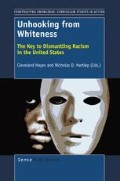Abstract
Asian Americans are considered to be “honorary” Whites (Tuan, 1998). This means that they are positioned as middlemen within the existing Black-White racial binary. In this racial binary, Asian Americans are triangulated between African Americans and Whites.
Access this chapter
Tax calculation will be finalised at checkout
Purchases are for personal use only
Preview
Unable to display preview. Download preview PDF.
References
Aoki, A. L. (2010). Coalition Politics. In E. W. Chen & G. J. Yoo (Eds.) Encyclopedia of Asian American issues today (volume 2) (pp. 707–712). Santa Barabara, CA: Greenwood Press.
Bell, D. A. (1980). Brown v. Board of education and the Interest-Convergence Dilemma. Harvard Law Review, 93(3), 518–533.
Bergerson, A. A. (2003). Critical race theory and white racism: is there room for White scholars in fighting racism in education? Qualitative Studies in Education, 16(1), 51–63.
Bikmen, N. (2011). Asymmetrical effects of contact between minority groups: Asian and Black students in small college. Cultural Diversity and Ethnic Minority Psychology, 17(2), 186–194.
Chae, Y. (2008). Cultural Economies of Model Minority Creation. In Y. Chae, (Ed.) Politicizing Asian American literature: Towards a critical multiculturalism (pp. 19–30). New York, NY: Routledge.
Choi, D. H. (1992, Spring). The other side of the model minority myth. Yisei Magazine, 5(2), 20–23, 25, 26. A digitized copy is available here: http://www.hcs.harvard.edu/~yisei/issues/spring_92/ys92_20.html
Dei, G. J. S., Karumanchery, L. L., & Karumanchery-Luik, N. (2007). Playing the race card: Exposing White power and privilege. New York, NY: Peter Lang.
Delgado, R. (1991). Affirmative action as a Majoritarian Device: Or, do you really want to be a role model? Michigan Law Review, 89(5), 1222–1231.
Devos, T., & Banaji, M. R. (2005). American = White? Journal of Personality and Social Psychology, 88(3), 447–466.
Dhingra, P. H. (2003). Being American between black and white: Second generation Asian American professionals racial identities. Journal of Asian American Studies, 6(2), 117–147.
Dixon, J. C. (2006). The ties that bind and those that don’t: Toward reconciling group threat and contact theories of prejudice. Social Forces, 84(4), 2179–2203.
DuBois, W. E. B. (1935). Black reconstruction in America: 1860–1880. New York: The Free Press.
Duncan-Andrade, J. M. R. (2009). Note to educators: Hope required when growing roses in concrete. Harvard Educational Review, 79(2), 181–194.
Freire, P., & Macedo, D. (1987). Literacy: Reading the word and the world. Westport, CT: Greenwood Publishing.
Fujino, D. C. (2008). Who studies the Asian American movement? A historiographical analysis. Journal of Asian American Studies, 11(2), 127–169.
Gillborn, D. (2005). Education policy as an act of white supremacy: Whiteness, critical race theory and education reform. Journal of Education Policy, 20(4), 485–505.
Gorski, P. (2012, February 6). Complicating White privilege: Poverty, class, and the nature of the knapsack. Teachers College Record. http://www.tcrecord.org ID Number: 16687
Hartlep, N. D. (2010). Going public: Critical race theory and issues of social justice. Mustang, OK: Tate.
hooks, b. (1992). Black looks: Race and representation. Boston: South End Press.
hooks, b. (1989). Talking back: Thinking feminist, thinking black. Boston, MA: South End Press.
Iijima, C. K. (1998). Reparations and the “model minority” ideology of acquiescence: The necessity to refuse the return to original humiliation. Boston College Law Review, 40(1), 385–427.
Kim, C. J. (1999). The racial triangulation of Asian Americans. Politics & Society, 27(1), 105–138.
Kim, E. (1998). At least you’re not black: Asian Americans in U.S. race relations. Social Justice, 25(3), 3–19.
Lee, S. J. (2005). Up against Whiteness: Race, school, and immigrant youth. New York, NY: Teachers College Press.
Lee, S., Juon, H., Martinez, G., Hsu, C. E., Robinson, E. S., Bawa, J., & Ma, G. X. (2009). Model Minority at risk: Expressed needs of mental health by Asian American Young Adults. Journal of Community Health, 34(2), 144–152.
Leonardo, Z. (2010). Race, Whiteness and education. New York: Routledge.
Lin-Fu, J. S. (1988). Population characteristics and health care needs of Asian Pacific Americans. Public Health Reports, 103(1), 18–27.
Loewen, J. W. (1988). The Mississippi Chinese: Between black and white. Prospect Heights, IL: Waveland Press.
Matsuda, M. J. (2010). We will not be used: Are Asian Americans the racial bourgeoisie? In J. S. Wu & T. C. Chen (Eds.) Asian American studies now: A critical reader (pp. 558–564). New Brunswick, NJ: Rutgers University Press.
Rothenberg, P. S. (2002). White privilege: Essential readings on the other side of racism. New York, NY: Worth Publishers
Royster, D. A. (2003). Race and the invisible hand: How white networks exclude black men from bluecollar Jobs. Berkeley, CA: University of California Press. Shim, D. (1998). From Yellow Peril Through Model Minority to Renewed Yellow Peril. Journal of Communication Inquiry, 22(4), 385–409.
Shrake, E. K. (2006). Unmasking the self: Struggling with the model minority stereotype and lotus blossom image. In G. Li & G. H. Beckett (Eds.) “Strangers” of the academy: Asian women scholars in higher education (pp. 178–194). Sterling, VA: Stylus.
Solórzano, D. G., & Yosso, T. J. (2002). Critical race methodology: Counter-storytelling as an analytical framework for education research. Qualitative Inquiry, 8(1), 23–44.
Tayag, M. (2011, Spring). Great expectations: The negative consequences and policy implications of the Asian American “Model Minority” Stereotype. Stanford Journal of Asian American Studies, 4, 23–31.
Taylor, C. R., Landreth, S., & Bang, H. (2005). Asian Americans in magazine advertising: Portrayals of the “model minority.” Journal of Macromarketing, 25(2), 163–174.
Tuan, M. (1998). Forever foreigners or honorary whites?: The Asian ethnic experience today. New Brunswick, NJ: Rutgers University Press.
Zhou, M. (2004). Are Asian Americans becoming “white?” Contexts, 3(1), 29–37.
Editor information
Editors and Affiliations
Rights and permissions
Copyright information
© 2013 Sense Publishers
About this chapter
Cite this chapter
Hartlep, N.D., Hayes, C. (2013). Interrupting the Racial Triangulation of Asians. In: Hayes, C., Hartlep, N.D. (eds) Unhooking from Whiteness. Constructing Knowledge. SensePublishers, Rotterdam. https://doi.org/10.1007/978-94-6209-377-5_9
Download citation
DOI: https://doi.org/10.1007/978-94-6209-377-5_9
Publisher Name: SensePublishers, Rotterdam
Online ISBN: 978-94-6209-377-5
eBook Packages: Humanities, Social Sciences and LawEducation (R0)


